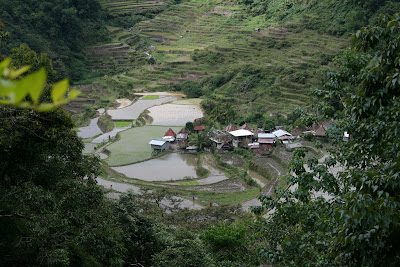
Having boarded a 6 a.m. flight in Guam, we arrived 3 1/2 hours later in Manila at 7:30 a.m., and headed straight north by car toward Banaue, to see the beautiful Ifugao rice terraces (acclaimed UNESCO historical site since 1995). The drive, as it turned out, was 10 hours long on the nose, if a little long in the teeth. En route, we visited the city of Cabanatuan, site of several POW camps in WWII, including Cabanatuan Prison Camp #2 in which my grandfather was imprisoned for a little over 2 years (1942-1944). Nothing is left of the camp sites which were actually located 5 miles east of Cabanatuan at Pangatian, so we pressed on. A roadside lunch of fish and chicken tamarind tided us over. The drive was diverting for the perpetual overtaking of overloaded jeepneys, motorcycles and 10-to-a-tricycles, zigzagging between uniformly sized dogs, thin chickens, pedestrians and kids all ages able to walk. It was not uncommon to find young kids (6-7 years old) carrying infants on their backs. Since all the homes (and businesses) line the road, the road was the children’s principal, if perilous, playground. Other sites included the drying of rice in one of the lanes (to make the two-way road a single lane), cows, carabao (local buffalo), goats and, of course, oncoming traffic.




***If you like my writing and are interested in fostering more meaningful conversations in our society, please check out my Dialogos Substack. This newsletter will feature articles on why and how we can all improve our conversations, whether it’s at home, with friends, in society at large or at work. Subscription is free, but if you see value in it, you are welcome to contribute both materially and through your comments. Sign up here:











I very much enjoyed your article about Banaue. Except for Gloria Arroyo’s event there, what you experienced in Banaue was the same I had in 1983!! Yes, same old dancers almost hunchbacked.
Sounds like a fantastic time – Was it just you two, or the whole family? A friend in Singapore has been trying to get us to visit Banaue for years – perhaps we’ll give it a second look now 🙂
@Mamluke: we went en famille: 2 adults, 2 kids. Definitely worth the trip, but watch out for the long road there!
Hi, Minter:
Re: the long drive. Next time perhaps you should charter helicopters…heh,heh.
Love,
Ginger